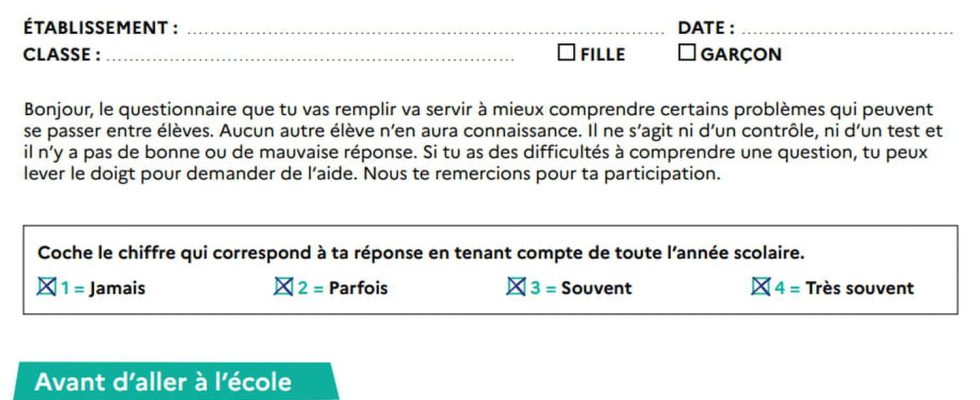The questionnaire aimed at detecting situations of school harassment is given this Thursday, November 9 to all students from CE2 to Terminale. The measure was promised by the Ministry of Education to improve the fight against bullying.
It arrives in schools this Thursday, November 9: the self-assessment questionnaire to detect situations of school harassment. The self-assessment grid was promised by the Ministry of National Education at the end of September among other measures to combat harassment. All students from CE2 onwards, as well as middle and high school students, will have two hours of ordinary lessons this Thursday, national anti-bullying day, to be made aware by their teachers of this subject and its sometimes dramatic consequences. The suicides of teenagers Lindsay, Lucas and Nicolas that have occurred in recent months seem to be linked to acts of harassment or cyberharassment.
During this normalized time, teachers must explain the means of prevention and detection of harassment situations, necessary to protect possible victims. Students are then given the questionnaire which they can complete anonymously. A measure viewed favorably by teaching unions and parent-teacher associations. But not everyone is convinced about the form which could lead to lengthy treatment of situations when the objective is to accelerate treatment, recall the union and association representatives.
Between 24 and 34 questions depending on the levels
The questionnaire on school bullying should allow students to talk about their state of mind and their relationship with school as well as their relationships with their classmates. The questions are therefore grouped into four parts targeting different aspects of the subject:
- Students’ apprehensions before going to school or its relationship to middle and high school: Are you afraid of going to school because of one or more students?
- Their daily life at school, college or high school: Did someone give you a mean nickname? Do one or more students make fun of you or insult you?
- Possible repercussions on the internet: Do you receive or have you seen insulting or threatening messages about you from one or more students on a phone? [ou] on social networks?
- Their feelings: Do you have trouble doing your homework because of what you experience at school? Do you have a stomach ache or a headache because of what you experience at school?
Although the form of the questionnaire is identical, the content changes somewhat depending on the age of the students. Three evaluation grids have been designed: the first for primary school students has 24 questions, while the other two intended for middle school students And to high school students are made up of 34 questions. For each question, the student must give a numerical answer ranging from 1 for a situation that never happens to 4 for a situation that occurs very often. The number of answers between 2 and 4 is greater, the more the student seems to be the victim of harassment or cyberharassment.
A prevention component included in the questionnaire
A series of around ten questions completes the questionnaire submitted to primary, middle and high school students. These questions are no longer used to analyze the student’s situation, but to find out whether those who “feel like they are being bothered” and are therefore likely to be victims of harassment have reported their situation to someone. . These questions are also an opening on prevention against school bullying whether students are victims, witnesses or actors.
An anonymous and non-obligatory questionnaire
It will be the teachers of the primary classes and the head teachers of the middle and high school classes – as far as possible – who will supervise the prevention sequence if possible accompanied by a member of the teaching and educational team. Before submitting the questionnaire, educational leaders must remind people of what harassment and cyberharassment are and warn of serious consequences.
If all students from CE2 to high school will receive the questionnaire and will be informed of the anonymity and confidentiality of the self-evaluation grid, they will not be obliged to complete it. However, teachers will be encouraged to encourage students to answer the questionnaire without forcing them.
Please note that when taking the questionnaire, all students who wish can ask to speak with a teacher, social and health staff or other educational staff to discuss their personal situation. The same will apply to students who show “a form of anxiety or distress”.
